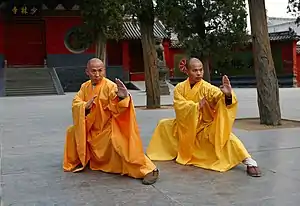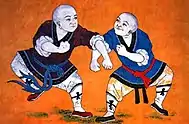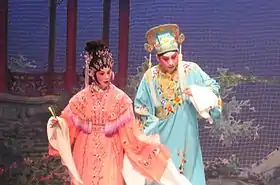History of Wing Chun
Wing Chun has been passed from teacher to student verbally rather than in writing, making it difficult to confirm (or clarify) differing accounts of the martial art's creation. Attempts have been made to apply methods of higher criticism to oral histories of Wing Chun and other Chinese martial arts,[1] and to discern the origins of Wing Chun by determining the purpose of its techniques. Wing Chun began to appear in independent documentation during the lifetime of 19th-century Wing Chun master Leung Jan, facilitating verification of its subsequent history and divergence into branches.
| Part of a series on |
| Chinese martial arts (Wushu) |
|---|
 |
Other origins for Wing Chun have been suggested, typically involving connections to the Triads, revolutionary groups (often anti-Qing), or the Hakka people of southern China.
Ng Mui Legend

Legend has it after escaping the destruction of the Fujian Shaolin Monastery by Qing forces around 1730, the Abbess Ng Mui fled to the Daliang Mountains on the border between Yunnan and Sichuan. Ng Mui often bought tofu at a shop owned by Yim Yee (嚴二). Yim Yee had a daughter named Yim Wing Chun (嚴詠春), whom a local warlord was trying to force into marriage. Ng Mui taught Yim Wing Chun a version of her southern-Shaolin kung fu, which allowed her to drive off the warlord.After completing her training under Ng Mui around 1790, Yim Wing Chun married Leung Bok-Chao (梁博儔) and taught the fighting techniques which Ng Mui had passed on to her. After Yim Wing Chun died around 1840, Leung Bok-Chao passed the new style on to Leung Lan-kwai.[2][3][4][5]
Leung Lan-kwai taught six members of the Red Boat Opera Group around 1850, and present-day Wing Chun descends from the six opera-group members: Yik Kam, Hung Gan Biu, Leung Yee-Tai, Wong Wah-bo, Dai Fa Min Kam, and Law Man Kung.
Yiu Kai
The legend of Yiu Kai dates the creation of Wing Chun to the early 19th century and identifies Yim Wing-chun's father as Yim Sei (嚴四), a disciple at the Fujian Shaolin Temple who avoids persecution by fleeing with his daughter to Guangxi. Yim Wing-chun learned the Fujian Shaolin arts from her father and, from their raw material, created a new style after seeing a fight between a snake and a crane. She married Leung Bok-Chao (梁博儔), a Shaolin disciple like Yim Wing-chun's father, and taught him her fighting style. The couple began teaching Wing Chun's fighting style to others after moving to Guangdong Province in 1815, settling in the city of Zhaoqing.
Other theories pertaining to Ng Mui / Wing Chun legend
According to legend, Wing-chun's lover Leung Bok-Chao was a student of Choy gar and helped shape Wing Chun.[6]
Wing Chun may have been created by the Five Elders of the Shaolin temple - which Ng Mui was part of - whose systems included white eyebrow, white crane, Shaolin, Hung Ga and Choy Li Fut.
Yong Chun White Crane
Fujian White Crane is descends in part from Shaolin Boxing / Ming-era Nanquan and imitates characteristics of the white Crane. Like the Ng Mui / Wing Chun legend, the Fujian White Crane too was, according to oral tradition, developed by a female martial artist, Fang Qiniang (方七娘; Amoy Min Nan: Hng Chhit-niâ).[7]
Qīniáng and her father lived in Yongchun County, Fujian province, where many cranes live. Both, words Yong Chun (Chinese: 永春; pinyin: Yǒngchūn; Min Nan: Éng-chhun; lit. 'eternal spring') and Wing Chun (Chinese: 詠春; Pinyin: Yǒng Chūn; Canto Yale: Wihng Cheūn; Literal meaning "beautiful springtime") bear resemblance to one another, both being romanized in Pinyin as Yong Chun.
Per legend, Qīniáng's father knew the Southern Chinese martial arts and taught them to his daughter. One day, Qīniáng was doing her chores, a crane landed nearby. Qīniáng tried to scare the bird off using a stick and the skills she had learned from her father, but whatever she did, the crane would counter and/or deflect the attacks.[8]
Much like Wing Chun, White Crane Kung Fu is too touted as having fighting elements that make it ideal for women's self-defense training because the movements do not require great strength.[9]
The technical similarities between Wing Chun and Fujian White Crane suggest that they are related. According to Ip Man's student, Leung Ting: "[The] Wing Tsun System is derived from the Fukien System of kung fu. Their common features are that during fights, pugilists of these systems prefer short steps and close fighting, with their arms placed close to the center, their elbows in and behind the arm and kept close to the flanks to offer it protection. Another characteristic of these two systems of kung fu is, unlike those of Kwangtung Province and Northern China, their boxing forms are rather simple".[10] Both styles also both styles emphasize evasion and attack an opponent's vulnerabilities instead of using physical strength.
Li Wenmao (李文茂), an opera performer and leader of the 1854–1856 Red Turban Rebellion in Foshan, is said to have been a Wing Chun White Crane practitioner.
Redboat Opera Company

Red Boat troupes had been an important platform for Wing Chun to build on in Guangdong, and some of the most famous Red Boat Performers such as Leung Lan Kui, leung Yee Tei, and Wong Wah Bo were all grand masters of Guangdong Wing Chun.[11]
Nearly all extant lineages of Wing Chun, except the Pao Fa Lien (刨花蓮) and Hek Ki Boen branches, claim to descend from the members of the mid-19th-century Red Boat Opera Company (紅船戲班). All Wing Chun descends from six Opera Boat members who were taught by Leung Bok-Chao from 1845 to 1855: Yik Kam, Hung Gan Biu, Leung Yee-Tai, Wong Wa-bo, Dai Fa Min Kam and Law Man Kung. Leung Yee-Tai used a pole to steer the Red Opera Boat away from rocks and shoals, and was chosen by Shaolin master Jee Shim to learn the six-and-a-half point pole. Through Jee Shim, the six-and-a-half point pole was added to the Wing Chun system. Leung Yee-Tai and Wong Wa-bo taught Leung Jan, whose students included his son, Leung Bik (梁壁); "Wooden Man" Wah (木人華) and Chan Wah-shun (陳華順, nicknamed "Moneychanger Wah" 找錢華), from whom the Ip Man, Yiu Kai and Pan Nam lineages descend.
"Dai Fa Min" Kam (大花面錦), who played the role of the martial painted face, is the ancestor of the Way Yan lineage. The Yuen Kay Shan and Pan Nam branches descend from Wong Wah-bo and "Dai Fa Min" Kam. Hung Gun Biu (紅巾彪) passed the art to his son-in-law, Yin Lee-Chung, and the Wang (王) family.
In the Red Boat Opera Company the virtuous female was played by Yik Kam (翼金), better known as Ching-Deng Kam because of the role he played. Cho Shun (曹順), who played the Little Martial (小武) role, was a student of Yik Kam. By passing the art on to his son, Cho Dak-Sang (曹德生), Cho Shun established the Wing Chun lineage of the Cho family from the village of Panyu.[12][11]
Espionage and assassination

According to one theory, opponents of the Qing dynasty used the Red Boat Opera Company as a cover to disguise themselves as a troupe of traveling entertainers. Their identities as Chinese opera performers provided cover for martial-arts training, but the flashy moves of opera-style martial arts were not suited to espionage and assassination. Although assassinations would be carried out with poison or knives, their targets were usually protected by bodyguards. Wing Chun was reportedly designed to deal with an opponent who seized rather than struck, silencing the opponent immediately. This would explain technical aspects of Wing Chun, such as its emphasis on close-range combat, trapping and its strikes to the throat and diaphragm.[13]
Tiandihui connection
Leung Jan was associated with Tiandihui via one of his teachers, Leung Yee-tai. Leung Jan had re-arranged the routine of Wing Chun based on the concept of harmony between heaven and earth - which the Tiandhui society was named after. There are only three basic routines in Wing Chun - "Shen Qiao", "Biao Zhi" and "Small Thoughts"; their respective action features correspond to heaven, earth and people. The mastery of the three basic routines becomes Tiandiren and the "Wooden Stake Method"; also known as the "108-style Wooden Stake Method". [14]
Further reading
Notes
| Chinese | Pinyin | Cantonese Yale | ||
|---|---|---|---|---|
| Yim Wing Chun | 嚴詠春 | yán yǒngchūn | yim4 wing2 cheun1 | |
| Yongchun | 永春 | yǒngchūn | wing5 cheun1 | literally "Everlasting Spring," the name of a town and its surrounding county in the prefecture of Quanzhou, Fujian Province known for its White Crane boxing |
| Wing Chun Bak Hok Kuen | 永春白鶴拳 | yǒngchūn báihèquán | wing5 cheun1 baak6 hok6 kyun4 | the style of White Crane boxing associated with the town of Yongchun, Fujian |
| Fong Chut-Neung | 方七娘 | fāng qīniáng | fong1 chat1 neung4 | Minnan: hng1 chhit1 nia5 |
| Fong Wing Chun | 方詠春 | fāng yǒngchūn | fong1 wing2 cheun1 | |
| Leung Jan | 梁贊 | liáng zàn | leung4 jaan3 | |
| Wong Wah-bo | 黃華寶 | huáng huábǎo | wong4 wa4 bou2 | |
| Leung Yee-Tai | 梁二娣 | liáng èrtì | leung4 yi6 tai5 | |
| Leung Chun | 梁春 | liáng chūn | leung4 cheun1 | |
| Leung Bik | 梁壁 | liáng bì | leung4 bik1 | |
| Chan Wah-Shun | 陳華順 | chén huáshùn | chan4 wa4 seun6 | nicknamed "Moneychanger Wah" (找錢華) |
| "Dai Fa Min" Kam | 大花面錦 | dàhuāmiàn jǐn | daai6 fa1 min6 gam2 | "Painted Face" Kam |
| "Hung Gun" Biu | 紅巾彪 | hóngjīn biāo | hung4 gan1 biu1 | "Red Bandanna" Biu or "Red Turban" Biu; the red turban, or red bandanna, was initially a symbol of opposition to the rule of the Mongol Yuan Dynasty that was revived by opponents of the Manchu Qing Dynasty |
| "Dai Dong Fung" | 大東風 | dàdōngfēng | daai6 dung1 fung1 | "Great East Wind" |
| Pao Fa Lien | 刨花蓮 | pàohuā lián | paau4 fa1 lin4 | "Wood-Planer Lien" |
| Yik Kam | 翼金 | yì jīn | better known as "Ching-Deng" Kam (??金; pinyin: "qingdan" jīn) because he played the role of the virtuous "female" | |
| Cho Shun | 曹順 | cáo shùn | ||
| Cho Dak-Sang | 曹德生 | cáo déshēng | chou4 dak1 saang1 |
References
- Chu, Ritchie, and Wu 1998
- Chu, Robert; Ritchie, Rene & Wu, Y. (1998). Complete Wing Chun: The Definitive Guide to Wing Chun's History and Traditions. Boston: Tuttle Publishing. ISBN 0-8048-3141-6.
- Chow, David & Spangler, Richard (1982). Kung Fu: History, Philosophy and Technique. Burbank: Unique Publications. ISBN 0-86568-011-6.
- Ing, K. (2008): Wing Chun warrior: The true tales of Wing Chun Kung Fu Master Duncan Leung, Bruce Lee's fighting companion. Hong Kong: Blacksmith Books. (ISBN 978-9-8817-7422-4)
- Stanford Wing Chun: History and principles of Wing Chun Kung Fu (c. 2001). Retrieved on 9 May 2010.
- "Choy Gar Kung Fu". Archived from the original on 9 May 2007. Retrieved 22 June 2018.
- Yang, Jwing-Ming (1 October 2016). The Essence of Shaolin White Crane: Martial Power and Qigong. YMAA Publication Center, Incorporated. ISBN 978-1-59439-160-6.
- "Fujian White Crane". Inter martial arts. Inner Martial Arts. Archived from the original on 11 January 2018. Retrieved 8 March 2016.
- "Fujian White Crane". Inter martial arts. Inner Martial Arts. Archived from the original on 11 January 2018. Retrieved 8 March 2016.
- Leung 1978, p. 30.
- Ye, Guo (4 July 2019). "Canton Kung Fu: The Culture of Guangdong Martial Arts". Sage Jurnals (Online). SAGE Publications Inc. Sage open. Retrieved 11 October 2020.
- DUHALDE, MARCELO (8 November 2019). "Cantonese performing art". South China Morning Post (Online). South China Morning Post. Retrieved 11 October 2020.
- "Cantonese Popular Culture and the Creation of Wing Chun's "Opera Rebels."". Chinesemartialstudies.com. Kung fu tea. Retrieved 8 October 2020.
- https://web.archive.org/web/20180211185948/http://www.macaodaily.com/html/2017-10/15/content_1214793.htm
Sources
- Chu, Robert; Ritchie, Rene; Wu, Y. (1998). Complete Wing Chun: The Definitive Guide to Wing Chun's History and Traditions. Boston: Tuttle Publishing. ISBN 0-8048-3141-6.
- Leung Ting (1978). Wing Tsun Kuen (PDF). Hong Kong: Leung's Publications. ISBN 962-7284-01-7.
- Ritchie, Rene; Chu, Robert; & Santo, Hendrik. "Wing Chun Kuen and the Red Junk Opera". Archived from the original on March 16, 2006. Retrieved August 14, 2005.
- Ritchie, Rene; Chu, Robert; & Santo, Hendrik. "Wing Chun Kuen and the Secret Societies". Archived from the original on March 16, 2006. Retrieved August 14, 2005.